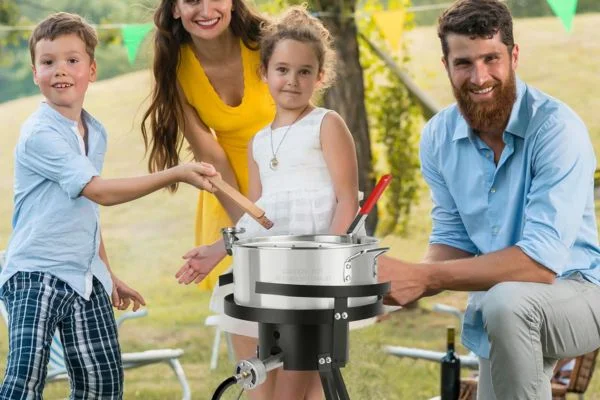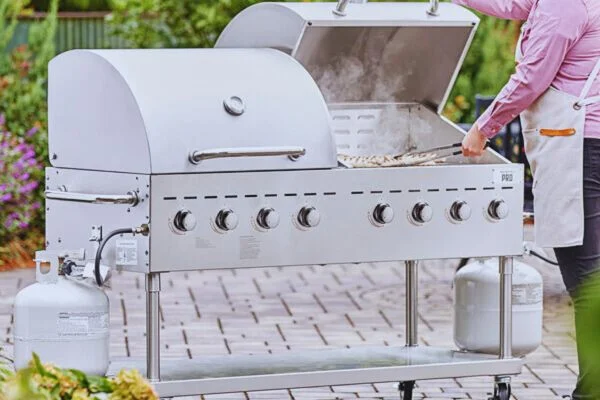If you’re looking to make fish fry night a regular event, then investing in a propane fish fryer is the way to go. It’s an easy, safe and efficient way to make delicious fried fish that will envy your neighborhood. Let’s look at how to use a propane fish fryer.
How To Use A Propane Fish Fryer | Pro Steps

Step#1 Safety Precautions
Prioritize safety before you begin. Propane fish fryers should be placed on stable, level surfaces, away from flammable materials. Connect the propane tank securely to the fryer and close the regulator valve. Use soapy water to check for gas leaks – bubbles will form if there is a leak. Never leave the fryer unattended and keep a fire extinguisher nearby.
Step#2Assembly
Start by assembling the propane fish fryer according to the manufacturer’s instructions. This involves attaching the burner to the propane tank and connecting the regulator hose. To prevent gas leaks, make sure all connections are tight.
Step#3 Filling the Fryer
Fill the fryer with your favorite cooking oil, being careful not to overfill it. You’ll find the amount of oil required in the user manual of your fryer, but it may vary depending on its size. Use the built-in thermometer or a separate cooking thermometer to heat the oil to the desired cooking temperature, typically between 350°F and 375°F (175°C and 190°C).
Step#4 Ignition
Check that the regulator is properly adjusted after turning on the propane tank valve. Use a long-reach lighter or an electronic ignition if your fryer has one to ignite the burner. Maintain the desired cooking temperature by adjusting the flame. Prevent pressure buildup by keeping the lid open while heating the oil.
Step#5 Frying Process
Once the oil reaches the desired temperature, carefully lower your food into it with tongs or a basket. Be careful not to splash hot oil. When your fish or other items are ready, cook them until they have reached your desired level of doneness. Remove the food from the fryer using the basket or a slotted spoon, allowing excess oil to drain back into the pot.
Step#6 Safety Shutdown
Turn off the burner after cooking by closing the propane tank valve first, then turning off the regulator. Drain the fryer oil after it has cooled completely. Drain the cooled oil into a suitable container for disposal or reuse. You should clean the fryer and all its components according to the manufacturer’s instructions to ensure safe and efficient operation.
Read more about Can You Fry Fish In A Turkey Fryer?
How Much Oil Do You Put In A Fish Fryer?
When it comes to deep-frying fish, there are a few essential steps to ensure that your food is cooked correctly and doesn’t stick. Before you begin, you’ll want to measure the right amount of oil for the fryer. After knowing how to use a propane fish fryer, Many people ask a common question about the oil amount in the fish fryer.
This may vary depending on the model of your fryer, but usually, you’ll need between two to three quarts of oil to have enough for deep-frying foods. It’s important not to overfill the pot with oil because this can create a dangerous environment or lead to uneven cooking.
Once you have the correct amount of oil in your fryer, turn it up to 375 degrees and heat it for about 5 minutes or until hot before adding your fish. With these simple steps, you’ll be able to enjoy delicious fried fish in no time!
Read more about How To Cook Fish While Camping?
How Long Do You Cook Fish On A Propane Grill?
Cooking fish on a propane grill can be a delicate process. Depending on the fish’s cut, size, and marinade, cooking times can vary greatly. Generally speaking, it’s best to start low and slow. If you turn the heat up too fast, your fish will most likely end up burnt and inedible.

For whitefish (such as tilapia or cod), cook the fish with indirect medium heat for 8-10 minutes, flipping halfway through. For fatty fish (like salmon), you’ll want to put direct medium-high heat for 6-8 minutes until it’s cooked all through.
Regardless of which type of fish you are grilling, one surefire way to ensure that it is done is with a thermometer inserted into its thickest part – anything from 145°F–160°F should denote your delicious dinner is ready!
Read more about How To Keep Fish Fresh While Camping?
How do you use a propane air fryer?
In order to use a propane air fryer, you need to follow several key steps. Using your propane air fryer to its full potential is as easy as following these six steps:
Step#1 Assemble and Connect
Set up your propane air fryer outdoors in a well-ventilated area. Prepare a propane tank and connect it safely to the air fryer according to the manufacturer’s instructions. Prevent gas leaks by securing all connections.
Step#2 Preheat the Air Fryer
Set the propane air fryer’s temperature control to your desired cooking temperature, typically between 300°F and 400°F (150°C to 200°C). For the best results, let the fryer preheat for about 10-15 minutes before cooking.
Step#3 Prepare Your Food
During preheating, season your food as desired. Adding flavor can be done with a variety of ingredients, such as oil, spices, or marinades. Dry food items will promote crispiness.
Step#4 Load the Basket
Put your prepared food in the fryer’s basket. Do not overcrowd the basket, as this may hinder air circulation and cause uneven cooking. Let some space between the items instead of arranging them in a single layer.
Step#5 Cooking Time and Temperature
You should close the air fryer’s lid and set the timer according to your recipe or the appliance’s manual. The basket needs to be flipped or shaken halfway through the cooking process in order to ensure even cooking. Different recipes require different temperatures and times.
Step#6 Check for Doneness
After the timer goes off, check your food’s doneness with a kitchen thermometer or visually. You may need to continue cooking for a few more minutes, checking your food regularly, until it reaches the desired crispiness and internal temperature.
FAQs about how to use a propane fish fryer
Can you use propane directly on food?
It is not recommended to use propane directly on food. Grills and stoves use propane as a fuel source because it is highly flammable. Propane can only be used for cooking appliances that are specifically designed for its safe use, such as propane grills and camping stoves. The direct exposure of food to propane can result in a range of health hazards, including contamination and harmful chemical reactions. Follow proper cooking procedures and equipment guidelines when using propane for cooking to ensure the safety of your food and yourself.
How do I know if my propane tank is empty?
Identify the propane tank’s gauge, typically located near the top of the tank, to determine if it is empty. The gauge dial is marked from 0% to 100%. Your tank is likely empty if the needle points to 0% or the red indicator appears. The propane level can also be determined by pouring warm water down the side of the tank and feeling for a cool spot. You can also listen for a hollow sound when tapping the tank. If you are unsure about the tank’s condition, consult a professional.
What is the best temperature to fry fish?
A temperature of 350 to 375 degrees Fahrenheit (175 to 190 degrees Celsius) is ideal for frying fish. The fish cooks quickly and evenly at this temperature range, creating a crispy outer layer while keeping the inside moist and tender. To avoid overcooking or becoming greasy, it’s important to maintain this temperature. You can achieve delicious, perfectly fried fish every time by monitoring the oil’s temperature with a thermometer.
Bottom Line
Now you know how to use a propane fish fryer. You’re ready to start frying like a pro with your propane-powered fish fryer! Remember that safety should always be a top priority when using any gas appliance, so read all instructions thoroughly before taking action and keep an eye out for any signs of danger (such as leaking gas) while in use. And with that being said, bon appétit!

